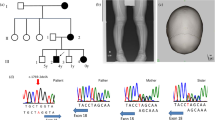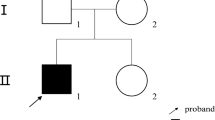Abstract
X-linked dominant hypophosphatemia (XLH, OMIM307800), the most prevalent form of inherited rickets in humans, is a dominant disorder of phosphate homeostasis characterized by growth retardation, rachitic and osteomalacic bone disease, hypophosphatemia, and renal phosphate wasting. The gene responsible for XLH was identified by positional cloning and designated PHEX (formerly PEX) to depict a phosphate-regulating gene homologous with endopeptidases on the X chromosome. Recently, extensive mutation analysis of the PHEX gene has revealed a wide variety of gene defects in XLH. The ethnic distribution of the mutations is very widespread but only a few mutations in Chinese have been reported. To analyze the molecular basis in three unrelated Chinese families with XLH, we determined the nucleotide sequence of the PHEX gene and fibroblast growth factor 23 (FGF23) gene of affected members. The serum FGF23 concentrations of these patients with XLH were also measured. Three different novel mutations were observed in these three families: one deletion mutation c.264delG causing p.W88 X; one missense mutation c.1673C>G causing p.P558A; one nonsense mutation c.1809G>A causing p.W603 X. Serum concentration of FGF23 in XLH patients of these three families was significantly higher than normal. The results suggest that PHEX gene mutations were responsible for XLH in these patients and these mutations may contribute to a higher serum FGF23 level.


Similar content being viewed by others
Abbreviations
- ADHR:
-
Autosomal dominant hypophosphatemic rickets
- FGF23:
-
Fibroblast growth factor 23
- HHRH:
-
Hereditary hypophosphatemic rickets with hypercalciuria
- HR:
-
Hypophosphatemic rickets
- PHEX:
-
Phosphate-regulating gene with homologies to endopeptidases on X chromosome
- TIO:
-
Tumor-induced osteomalacia
- XLH:
-
X-linked dominant hypophosphatemic rickets
References
Rasmussen H, Tenenhouse HS (1995) Mendelian hypophosphatemias. In: Scriver CR, Beaudet AL, Sly WS, Valle D (eds) The Metabolic and Molecular Basis of Inherited Disease, vol 2. McGraw Hill, New York, pp 3717–3745
Whyte MP, Schranck FW, Armamento R (1996) X-linked hypophosphataemia: a search for gender, race, anticipation, or parent of origin effects on disease expression in children. J Clin Endocrinol Metab 81:4075–4080
Econs MJ, McEnery PT (1997) Autosomal dominant hypophosphataemic rickets/osteomalacia: Clinical characterization of a novel renal phosphate wasting disorders. J Clin Endocrinol Metab 82:674–681
Rowe PS (1994) Molecular biology of hypophosphataemic rickets and oncogenic osteomalacia. Hum Genet 94:457–467
HYP Consortium (1995) A gene (PEX) with homologies to endopeptidases is mutated in patients with X-linked hypophosphatemic rickets. Nat Genet 11:130–136
Rowe PS, Goulding JN, Francis F, Oudet C, Econs MJ, Hanauer A, Lehrach H, Read AP, Mountford RC, Summerfield T, Weissenbach J, Fraser W, Drezner MK, Davies KE, O’Riordan JL (1996) The gene for X-linked hypophosphataemic rickets maps to a 200–300 kb region in Xp22.1, and is located on a single YAC containing a putative vitamin D response element (VDRE). Hum Genet 97:345–352
Holm IA, Huang X, Kunkel LM (1997) Mutational analysis of the PEX gene in patients with X-linked hypophosphatemic rickets. Am J Hum Genet 60:790–797
Du L, Desbarats M, Viel J, Glorieux FH, Cawthorn C, Ecarot B (1996) cDNA cloning of the murine Pex gene implicated in X-linked hypophosphatemia and evidence for expression in bone. Genomics 36:22–28
Jonsson KB, Zahradnik R, Larsson T, White KE, Sugimoto T, Imanishi Y, Yamamoto T, Hampson G, Koshiyama H, Ljunggren O, Oba K, Yang IM, Miyauchi A, Econs MJ, Lavigne J, Juppner H (2003) Fibroblast growth factor 23 in oncogenic osteomalacia and X-linked hypophosphatemia. N Engl J Med 348:1656-1663
Weber T, Liu S, Indridason O, Quarles LD (2003) Serum FGF23 levels in normal and disordered phosphorus homeostasis. J. Bone Miner Res 18:1227–1234
Bowe AE, Finnegan R, Jan de Beur SM, Cho J, Levine MA, Kumar R, Schiavi SC (2001) FGF23 inhibits renal tubular phosphate transport and is a phex substrate. Biochem Biophys Res Commun 284(4):977-981
Liu S, Guo R, Simpson LG, Xiao ZS, Burnham CE, Quarles LD (2003) Regulation of fibroblastic growth factor 23 expression but not degradation by PHEX. J Biol Chem 278:37419–37426
Liu S, Zhou J, Tang W, Jiang X, Rowe DW, Quarles LD (2006) Pathogenic role of Fgf23 in Hyp mice. Am J Physiol Endocrinol Metab 291:E38–E49
Rowe PS, Oudet CL, Francis F, Sinding C, Pannetier S, Econs MJ, Strom TM, Meitinger T, Garabedian M, David A, Macher MA, Questiaux E, Popowska E, Pronicka E, Read AP, Mokrzycki A, Glorieux FH, Drezner MK, Hanauer A, Lehrach H, Goulding JN, O’Riordan JL (1997) Distribution of mutations in the PEX gene in families with X-linked hypophosphataemic rickets (HYP). Hum Mol Genet 6:539–549
Jan de Beur SM, Levine MA (2002) Molecular pathogenesis of hypophosphatemic rickets. J Clin Endocrinol Metab 87:2467–2473
Cho HY, Lee BH, Kang JH, Ha IS, Cheong HI, Choi Y (2005) A clinical and molecular genetic study of hypophosphatemic rickets in children. Pediatr Res 58:329–333
Cho HY, Lee BH, Kang JH, Ha IS, Cheong HI, Choi Y (1998) A PHEX gene mutation is responsible for adult-onset vitamin d-resistant hypophosphatemic osteomalacia: evidence that the disorder is not a distinct entity from x-linked hypophosphatemic rickets. J Clin Endocrinol Metab. 83:3459–3462
Holm IA, Nelson AE, Robinson BG, Mason RS, Marsh DJ, Cowell CT, Carpenter TO (2001) Mutational analysis and genotype-phenotype correlation of the phex gene in X-linked hypophosphatemic rickets. J Clin Endocrinol Metab 86:3889-3899
Francis F, Strom TM, Hennig S, Boddrich A, Lorenz B, Brandau O, Mohnike KL, Cagnoli M, Steffens C, Klages S, Borzym K, Pohl T, Oudet C, Econs MJ, Rowe PS, Reinhardt R, Meitinger T, Lehrach H (1997) Genomic organization of the human PEX gene mutated in X-linked dominant hypophosphatemic rickets. Genome Res 7:573–585
Walton RJ, Bijvoet OL (1975) Nomogram for derivation of renal threshold phosphate concentration. Lancet 2(7929):309–310
Imel EA, Peacock M, Pitukcheewanont P, Heller HJ, Ward LM, Shulman D, Kassem M, Rackoff P, Zimering M, Dalkin A, Drobny E, Colussi G, Shaker JL, Hoogendoorn EH, Hui SL, Econs MJ (2006) Sensitivity of fibroblast growth factor 23 measurements in tumor-induced osteomalacia. J Clin Endocrinol Metab 91:2055–2061
Yamazaki Y, Okazaki R, Shibata M, Hasegawa Y, Satoh K, Tajima T, Takeuchi Y, Fujita T, Nakahara K, Yamashita T, Fukumoto S. (2002) Increased circulatory level of biologically active full-length FGF23 in patients with hypophosphatemic rickets/osteomalacia. J Clin Endocrinol Metab 87:4957–4960
Lo FS, Kuo MT, Wang CJ, Chang CH, Lee ZL, Van YH (2006). Two novel PHEX mutations in Taiwanese patients with X-linked hypophosphatemic rickets. Nephron Physiol 103:157-163
Tyynismaa H, Kaitila I, Nanto-Salonen K, Ala-Houhala M, Alitalo T (2000) Identification of fifteen novel PHEX gene mutations in Finnish patients with hypophosphatemic rickets. Hum Mutat 15:383-384
Sabbagh Y, Boileau G, DesGroseillers L, Tenenhouse HS (2001) Disease-causing missense mutations in the PHEX gene interfere with membrane targeting of the recombinant protein. Hum Mol Genet 10:1539–1546
Sabbagh Y, Boileau G, Campos M, Carmona AK, Tenenhouse HS (2003) Structure and function of disease-causing missense mutations in the PHEX gene. J Clin Endocrinol Metab 88:2213-2222
Tenenhouse HS (1999) X-linked phypophosphataemia: a homologous disorder in humans and mice. Nephrol Dial Transplant 14:333-341
Shimada T, Mizutani S, Muto T, Yoneya T, Hino R, Takeda S, Takeuchi Y, Fujita T, Fukumoto S, Yamashita T (2001) Cloning and characterization of FGF23 as a causative factor of tumor-induced osteomalacia. Proc Natl Acad Sci USA 98:6500–6505
Larsson T, Marsell R, Schipani E, Ohlsson C, Ljunggren O, Tenenhouse HS, Juppner H, Jonsson KB (2004) Transgenic mice expressing fibroblast growth factor 23 under the control of the alpha1(I) collagen promoter exhibit growth retardation, osteomalacia, and disturbed phosphate homeostasis. Endocrinology 145:3087–3094
Bai X, Miao D, Li J, Goltzman D, Karaplis AC (2004) Transgenic mice overexpressing human fibroblast growth factor 23 (R176Q) delineate a putative role for parathyroid hormone in renal phosphate wasting disorders. Endocrinology 145:5269–5279
Saito H, Kusano K, Kinosaki M, Ito H, Hirata M, Segawa H, Miyamoto KI, Fukushima N (2003) Human fibroblast growth factor−23 mutants suppress Na-dependent phosphate co-transport activity and 1,25-dihydroxyvitamin D3 production. J Biol Chem 278:2206–2211
Acknowledgments
The authors thank Dr. Huiyuan Luo (Department of Medical Genetics, Institute of Basic Medical Sciences, Chinese Academy of Medical Sciences and Peking Union Medical College) and Dr. David Huanzhu Ke (Department of Metabolic Disorders, Bone and Mineral Metabolism, Amgen, Inc.) who provided helpful discussion. They are also indebted to the support provided by the National Natural Science Foundation of China (NSFC) under grant No. 30370781 and Doctoral Fund of Ministry of Education of China under grant No. 20040023055.
Author information
Authors and Affiliations
Corresponding author
Rights and permissions
About this article
Cite this article
Xia, W., Meng, X., Jiang, Y. et al. Three Novel Mutations of the PHEX Gene in Three Chinese Families with X-linked Dominant Hypophosphatemic Rickets. Calcif Tissue Int 81, 415–420 (2007). https://doi.org/10.1007/s00223-007-9067-4
Received:
Accepted:
Published:
Issue Date:
DOI: https://doi.org/10.1007/s00223-007-9067-4




